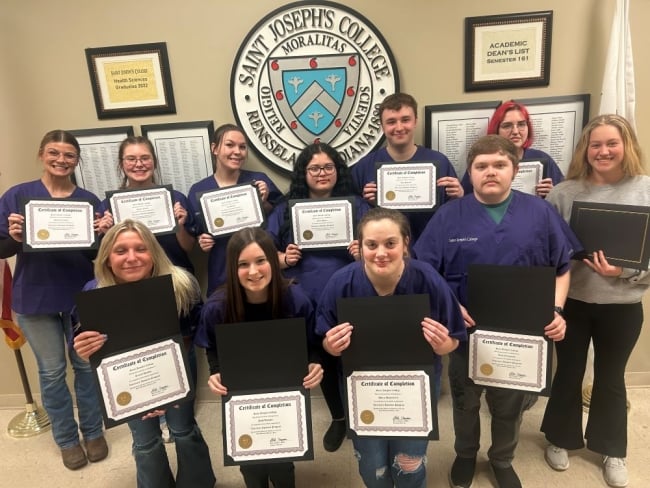You have /5 articles left.
Sign up for a free account or log in.

Saint Joseph’s College can no longer provide degrees after it suspended operations, so it transitioned to primarily offering workforce-oriented certificate programs.
Saint Joseph’s College
Saint Joseph’s College, a Catholic institution in Indiana, suspended operations seven years ago and lost its accreditation, beset by financial troubles. Deferred maintenance issues piled up; the institution was $27 million in debt. As the region’s traditional college-age population dwindled, enrollment declined to about 900 students in 2017 from a peak of about 1,500 in the 1960s.
Now the campus is bustling again, having gone through a bold but somewhat controversial transformation. The college has reinvented itself as a hub for short-term workforce training programs in Rensselaer, the small city in rural northwestern Indiana where it’s located. Using adjunct instructors, it offers a range of certificate programs, including in various health-care fields, veterinary sciences and a newly launched commercial driver’s license program. Tuition ranges from $500 to $2,100 per program this fall, and the longest certificate program, for veterinary assistants, spans just 16 weeks.
Saint Joseph’s, which is still unaccredited, provides credit-bearing courses as well through a partnership with Bethel University, a private Christian institution in Minnesota. Starting this summer, it also launched an initiative for high school students through its building and trades program, in which students construct houses for local residents on the campus’s empty farmland.
Bill Carroll, the college’s executive director, said Saint Joseph’s made the transformation because otherwise it would’ve had to close permanently.
“The bottom line is we were sinking fast and the board made a tough, tough decision,” he said. But as demand for short-term workforce training grows, “it’s looking like it was a decision made ahead of its time.”
‘A Cat With 50 Lives’
Change isn’t new for the college.
Saint Joseph’s was founded as Saint Joseph’s Orphan Asylum and Manual Training School in the 1860s, then morphed into a Catholic boarding school for Native American boys two decades later, according to the college’s website. Over the years, it retained its Catholic identity but went from an institution that trained teachers and priests to a men’s junior college, then a four-year college, then finally a coed institution, allowing women to live on campus by the 1960s.
“Saint Joseph’s is like a cat with 50 lives,” Carroll said.
As far as campus leaders are concerned, this iteration of Saint Joseph’s best fits the needs of the local community.
Nationally, “many of our rural institutions act as if they live in the city,” Carroll said, offering programs like philosophy and literature rather than those that train students for jobs in local industries. While Saint Joseph’s might not be able to offer philosophy courses anymore, it can train students for in-demand fields in the area, such as truck driving.
About 400 students have graduated from certificate programs since the college regrouped and pivoted in 2019, he noted. (The nearest community colleges, including Kankakee Community College and the Lafayette campus of Ivy Tech Community College, are an hour or more away.)
Rachel Lattimore, the college’s new CEO, said that a minority of high school graduates in the five counties that Saint Joseph’s serves goes on to earn a college degree.
“What happens to the rest of those students if you don’t have a path and an opportunity?” she said. “Especially in an agricultural or a low-economic area, you don’t have a future, you don’t have financial stability, you can’t be independent, and then you kind of flounder.” She added that the new model also better accommodates older adult learners looking to upskill or make a career change.
“We’re not training people to become doctors and engineers,” she said. “A four-year institution, traditional education, has its place.”
In another departure from tradition, Saint Joseph’s leaders aren’t especially interested in pursuing accreditation right now. Without accreditation, students can’t use federal financial aid to pay for programs that would typically be eligible: those that are at least 15 weeks long and offer 16 credit hours.
Carroll said the Higher Learning Commission, the institution’s previous accreditor, holds colleges to a “very high bar” that Saint Joseph’s can’t yet meet, including standards regarding the number of faculty. He believes the college’s workaround, providing credit-bearing coursework in partnership with an accredited university, is effective. As far as he’s concerned, a certificate program’s quality should be determined by how many students pass their exams for industry-recognized certifications and licenses—not whether an accreditor has given its stamp of approval.
Accreditation might be an option down the line, but “we will go where the market leads us,” he said. He sees the current model as a “bridge to the future.”
Michael Horn, co-founder of the Clayton Christensen Institute for Disruptive Innovation, a nonpartisan think tank, and an expert on college closures and mergers, said accreditation isn’t necessarily the best or only imprimatur of quality. For example, he believes working to meet education quality outcomes standards developed by the organization Jobs for the Future could help an institution like Saint Joseph’s prove its worth. But abandoning the goal of accreditation does raise questions, Horn said.
“How do they demonstrate that they are a better return on investment for short-term programs compared to what is a pretty crowded marketplace: community colleges, online programs, all sorts of things there,” he said. “Maybe they feel like their brand in the region will carry the day—I don’t know.”
While that might be a “reasonable bet,” Saint Joseph’s needs to find other ways to signal to prospective students, “This is a program that will get you to where you want to go,” he added.
Shifting Trends
Saint Joseph’s isn’t the only college to move away from the liberal arts and toward workforce-related offerings in recent years.
Catholic higher education in particular has had a recent influx of emergent, workforce-oriented institutions at a time when a growing list of small, private Catholic institutions have had to merge or close.
A number of new Catholic trade schools have recently launched, including Santiago Trade School in California, which prepares students for apprenticeships, and Harmel Academy of the Trades in Michigan, which exposes students to different trades and puts them into apprenticeships. Some emergent colleges are also offering degrees alongside workforce-oriented programs. The College of St. Joseph the Worker in Ohio, opening this fall, will offer a six-year program in which students earn a bachelor’s degree in Catholic studies while apprenticing in a trade of their choice to earn journeyman status.
Some higher ed institutions are shifting their offerings and cutting liberal arts programs in response to growing skepticism about the returns of a college degree, a drop in high school students going straight to college and a demand for more direct routes to jobs, Horn said. But it’s rare to see an institution “doing such a fundamental rethink of mission” as Saint Joseph’s, though there have been a few other examples.
“It’s good to see some adaptability and moves toward where they think the future is going,” he said. “I don’t think Stanford and Harvard and Yale are going to make that pivot, nor should they, probably. But if you’re a rural, small college in the Midwest or Northeast, you have to think of a value proposition that really works.”
A ‘Bruised’ Community
Not everyone is pleased with the shift at Saint Joseph’s.
The shuttering of the college in 2017 left some members of the community—especially alumni—smarting. Many local residents, including faculty members, lost their jobs. A nearby Arby’s that relied on college students’ business shut down. None of the programs alumni might reminisce about still exist.
“Alumni want to see the institution they went to, except [with Saint Joseph’s] each decade is a different institution,” Carroll said. In general, “the community is bruised. The community is hurting.”
The Reverend Jeffrey Kirch, an alum of the college, a former instructor and now a board member, said there’s a “sense of grief” over the version of the college that alumni knew and lost. Kirch is also the provincial director of the U.S. Province of the Missionaries of the Precious Blood, the religious order that oversees the college. Members of the group, many of whom attended Saint Joseph’s, also initially found the college’s shift to be a “gut punch.”
“We all lament losing some of those elements of the collegiate life that are important,” he said, recalling football games and core liberal arts courses. “But at the same time, our question as the board … is how do we fulfill our mission today, in the environment that we find ourselves in today?”
Kirch also sees the new version of the college as a continuation of its Catholic mission.
“Our parishioners struggle with the extreme cost of a baccalaureate education,” he said. “And when we see our parishioners coming out of a four-year school loaded with debt, [we ask], how can we provide a quality education that will help improve our parishioners’ lives?”
Carroll said he recognizes it isn’t going to be easy to regain the community’s trust. To that end, Saint Joseph’s is hosting an alumni homecoming event this month in the hopes of showing them firsthand that the college lives on, albeit differently. And college leaders are engaged in “outreach to the community, saying, ‘Come on in, trust us now.’”
“I understand their shyness about trusting—they got burnt, really badly,” he said. “And we’re trying to come back from that.”





